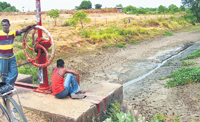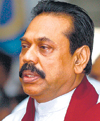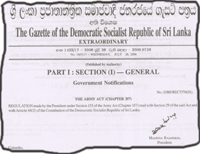 |
||||||||
| |
||||||||
|
LTTE in move to destabilize east
It was the toughest week for the nine-month-old regime of President Mahinda Rajapaksa.
He had to cope with mounting threats to the country's national security on two fronts. Ironically one was from within the Government in the form of strikes and threatened go-slows. They portended a severe blow to the nation's economy and threatened to bring life to a standstill countrywide. The other was clear moves by the Liberation Tigers of Tamil Eelam (LTTE) to slowly but surely inch their way towards an all out war. The news of a countrywide strike by workers of the Ceylon Petroleum Corporation (CPC) angered President Rajapaksa. It was coming hard on the heels of a strike by trade unions in the Colombo Port that cost billions of rupees in the form of losses. The CPC unions were demanding the removal of the newly appointed Chairman of the CPC subsidiary, Ceylon Petroleum Storage Terminals Ltd., one time Sri Lankan test cricketer and now Selection Committee Chairman Asantha de Mel. The strike forced a heavy draw from filling stations countrywide. Its continuation would have brought life to a total standstill. The consequences would have been unimaginable with the working of business, commerce and industrial sectors being crippled. The thermal power station at Kelanitissa was left with diesel for only three days. The continuation of the strike would have meant chaos countrywide and spelt economic disaster. This was at a time when the Government was facing mounting threats from the LTTE. President Rajapaksa summoned an emergency cabinet meeting on Monday. He told his ministers there were mischievous attempts being made by a hidden force to destabilize the Government. He said there was no legitimate cause for the CPC strike. Mr. de Mel had chaired three board meetings and the Government had granted a 23 per cent salary increase to petroleum workers in the recent past. Like the strike at the Colombo Port, the one by CPC workers was posing a dangerous threat. Ironically the strike was being staged by trade unions of the Sri Lanka Freedom Party (SLFP) and the Janatha Vimukthi Peramuna (JVP), those who backed Mr. Rajapaksa at the presidential polls. President Rajapaksa announced he had decided to take tough measures to cope with the situation. Otherwise people throughout the country would be forced to suffer hardships, he pointed out. He had decided to declare the petroleum sector as an "Essential Service." With that, he had wanted to move the security forces to transfer bowser loads of fuel to filling stations countrywide. But before a Gazette notification promulgating regulations under the ongoing State of Emergency could roll out of the Government Press on Tuesday, the strike was settled. The advisor to the President on trade union affairs, Bharatha Lakshman Premachandra, had successfully urged the trade unions to call off the strike. He had assured that the disputed issue - removal of Mr. de Mel as Chairman - would be resolved within two weeks. Until then, he would not enter his office or exercise any executive authority. The strike ended but President Rajapaksa was surprised. He had not mandated Mr. Premachandra to give such an assurance on his behalf. "How can the President subject all his appointments to suit the needs of trade unions," asked an aide who did not wish to be identified. However, the issue was resolved in the Colombo District Court on Thursday. The Government would amalgamate the Ceylon Petroleum Storage Terminals Ltd. (CPSTL) with the parent body, the Ceylon Petroleum Corporation. For this purpose a Cabinet Paper had been forwarded by the Minister of Petroleum Resources A.H.M. Fowzie. Thereafter all would become CPC employees. The process will take time but Mr de Mel was back at his Chairmain's office in the CPSTL on Friday, just three days after the unions wanted him removed. The foremost question that begs answer is why the trade unions were not told in advance of the cabinet paper and thus a very costly strike averted. President Rajapaksa, in the meanwhile, initiated a new process. He began meeting major trade union leaders in the company of ministers under whose ministry they functioned. This was after he personally tlephoned them. The immediate purpose was to ascertain from them the issues they faced and how the Government could address them. He is also to seek meetings with leaders of the Janatha Vimukthi Peramuna (JVP) and the Jathinka Hela Urumaya (JHU), the two parties backing the Government, to discuss ways and means of continuing a dialogue with trade unions to prevent strikes or go-slows. President Rajapaksa also telephoned Ceylon Workers Congress (CWC) leader Arumugam Thondaman, now in New York, to apprise him of the situation and seek his support. He won an assurance. The President also spoke with Periyasamy Chandrasekeran, President of the Up Country People's Front (UPFA). He extended his support and told Mr. Rajapaksa he was heading for Kilinochchi during the weekend to meet LTTE leaders. But the sequence of events this week over the CPC strike leaves behind some frightening thoughts. They show very clearly that like the go-slow at the Colombo Port, the strike by petroleum sector trade unions, if prolonged, would have led to disastrous consequences to the country's economy and brought about widespread public disgust. Unlike the go-slow at the Colombo port, the strike in the petroleum sector would have had a devastating effect on national security. The declaration of this sector as an Essential Service under the emergency would have entailed the deployment of troops if the unions resisted the order. Such a deployment of security forces and police would have to be countrywide. They have to ensure the transport and distribution of fuel among other matters. That would have to be at the expense of counter terrorism tasks assigned to them. It could have forced the Government to withdraw troop strength from vulnerable areas. In such an event, it would not have been a surprise if the LTTE seized the opportunity to carry out attacks in Colombo or in key towns and force the Government on its knees. This is particularly in view of increasing evidence that the LTTE is making intense preparations and stepping up the ongoing "low intensity" war. Some of these aspects came up for discussion on Wednesday when President Rajapaksa chaired the weekly meeting of the National Security Council. A matter that drew his attention was reports that the LTTE was preparing for chemical warfare. Facilities for such a move were being directed reportedly from a building in the Wanni with provision for underground storage. Another was last week's The Sunday Times (Situation Report) revelation of suspicions by the Sri Lanka Air Force that the LTTE was constructing a new airstrip in the Wanni. This is in addition to the one that exists near Kilinochchi, south east of the Iranamadu irrigation tank. Israeli built Kfir interceptor jets on Thursday bombed the mile long clearing where workers were reportedly busy with construction work. Air Force officials say they had successful hits when seven bombs were dropped in areas where guerrilla cadres were busy with chores that included leveling the ground for paving. That was close to a temporary building that lay on the outer fringe of a kilometer long area that has been cleared. Confirmation of this came from an Air Force reconnaissance aircraft which observed the guerrillas hurriedly move two heavy trucks to a location where bombs fell. They were believed to be evacuating the injured to hospital. Another matter of serious concern for the security establishment was the LTTE's blockade of water from Mavil Aru near the boundary that divides the districts of Trincomalee and Batticaloa. The anicut that channels water to farmlands (north of Batticaloa) are located within the Trincomalee district. Some 30,000 acres of paddy in the villages near Seruwila in Trincomalee district, ready for harvest, the Government fears, would be destroyed by this LTTE move. This is besides vast tracts of land cultivated with vegetables by those living in threatened villages north of Batticaloa. The Air Force began a three day air campaign on LTTE positions at Verugal, near the river that divides Trincomalee and Batticaloa districts. It began on Wednesday evening, just two hours after the meeting of the National Security Council. In one raid, Army sources said 16 guerrillas were killed and nearly 30 were injured. This was after a bomb dropped from the Kfir hit a guerrilla camp accurately in Verugal. The LTTE admitted the air raid in their websites but claimed only five cadres were killed. This unusual admission of air raids and the disclosure of casualties seem to have a purpose. That is to highlight that the air raid was conducted despite a ceasefire and to justify their actions when they carry out a retaliatory attack. The Media Centre for National Security quoted defence spokesman Keheliya Rambukwella as saying that the air raids were conducted "purely on humanitarian grounds" to neutralize disruptive forces that were preventing the free flow of water to the civilian population. The Verugal river was the scene of a major stand off between cadres loyal to the LTTE leadership in the Wanni and the renegade Karuna faction. Wanni cadres gathered on the Trincomalee side of the river. Loud hailers were used to play Tamil martial music and air stirring speeches to the Karuna faction who lay on the Batticaloa side of the same river. That was the prelude to the offensive by Wanni cadres to attack the Karuna faction on April 9, 2004. If the Karuna faction thought an attack would come from across the river, they were surprised when they were hit from the rear. That saw the exit of Karuna (Vinayagamoorthy Muralitharan) from the battlefield. But, before his withdrawal Karuna did cause considerable damage to the LTTE. He had disbanded the young cadres he had raised in the east and destroyed some weaponry including a large number of mortars. Though LTTE leader Velupillai Prabhakaran pumped in armed cadres from the Wanni and coaxed a section of the Karuna group to join in, the formidable strength with which the LTTE operated was lost. This was after Karuna parted ways. His group has continued to remain more than a nuisance to the Wanni cadres. This explains why the LTTE gave priority to its demand to disband the Karuna faction during the first round of talks with the Government in Geneva in April this year. Highlighting the role of the Karuna faction in the east was Friday's incident near the LTTE entry-exit point at Vavunativu. Two suicide cadres of the Karuna faction had wanted to go into the guerrilla held area. Their mission was to assassinate Banu, the LTTE Military Wing leader for Batticaloa. However, the two men and the three wheeler scooter taxi they were traveling in were checked. They exploded themselves. Four LTTE cadres were reported killed. By a strange quirk of fate "Col." Banu was among those injured yesterday when Air Force Kfir jets bombed LTTE's main base in Karadiyanaru, west of Batticaloa. The incident, military sources said, left over 40 guerrilla cadres dead and an unknown number injured. The LTTE played down the incident and claimed Banu was not present. However, intelligence sources said he was there together with "Col" Jeyam alias Balaguru Suventhiran. The latter had gone to Batticaloa to replace Banu who was to return to Kilinochchi. The LTTE was in the process of effecting a reshuffle of its military leaders. Together with renegade leader Karuna, Banu was regarded as leading frontline fighters of the LTTE. Banu also heads the LTTE's artillery wing. The LTTE move to place a water blockade at Mavil Aru is clearly a part of a grand military design to destabilize the east, particularly the Batticaloa district. It believes that the continued denial of water and repeated threats on the villages would lead to civilians in the area leaving their abodes. That would ensure a contiguous route for them into Batticaloa from areas south of Trincomalee which they now dominate. In their plans to step up the "low intensity" war into an all out one, such an arrangement becomes necessary for many reasons. Most important among them is to gain greater military control in the east which forms part of their so called separate state of Eelam. The spate of incidents this week, no doubt, will draw retaliation from the LTTE. That such strikes can become venomous in the light of Banu's reportedly being injured is no secret. With the LTTE inching towards an all out war, President Mahinda Rajapaksa now faces a formidable task. He has to make sure trade unions supporting him resist from strike action and help him face the bigger threat - the outbreak of a full scale Eelam War IV. That it is round the corner is no longer a guess.
|
||||||||
Copyright © 2001 Wijeya Newspapers
Ltd. All rights reserved. |
||||||||


